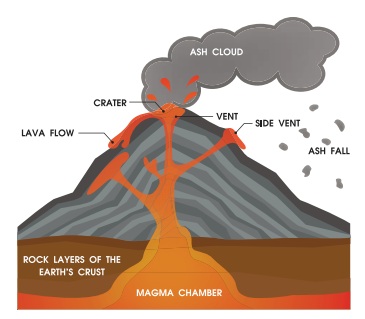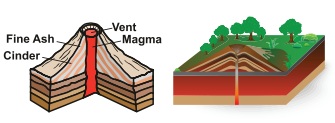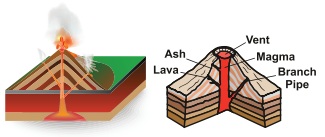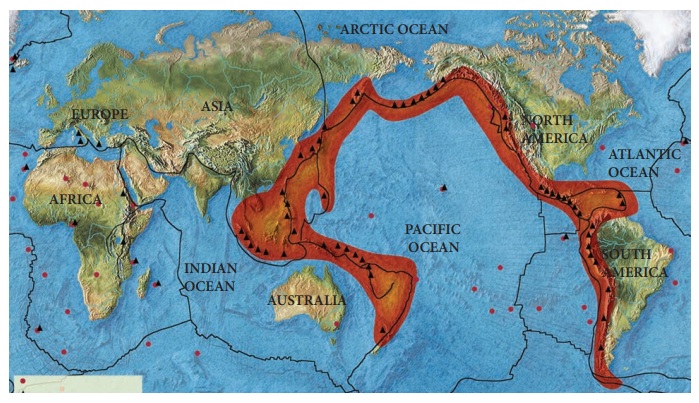Interior of the Earth | Term 1 Unit 1 | Geography | 7th Social Science - Volcanoes | 7th Social Science : Geography : Term 1 Unit 1 : Interior of the Earth
Chapter: 7th Social Science : Geography : Term 1 Unit 1 : Interior of the Earth
Volcanoes
Volcanoes
A volcano is a vent or an opening in
the earth’s crust through which hot magma erupts from deep below the surface.
The opening is usually circular in form.
Volcanic eruptions may also take place
through a long crack or fissure through which steam and other materials flow
out.

The
molten rock material within the earth, together with gases, is called magma. After it rises to the surface, it is called
as lava. In course of time, lava and other
materials flow out of a volcano accumulate around the opening and form a
conical hill or a mountain vent is an
openning or mouth of a volcano. The top of this cone is usually marked by a
funnel-shaped depression, which is called a crater.
If the crater of a volcano is of great size and is shaped like a basin, it is called a caldera. Calderas are caused by violent
explosions which blow away entire tops of great cones.
Causes of Volcanic Activity
The
temperature increases as the depth increases at the rate of 1ºc for every 35
metres. There is also great pressure. At a depth of about 15 km the pressure is
about 5 tonnes per cm2of rock. Under these circumstances, the interior of the
earth is in a semi-molten state called magma. The magma, under great pressure
has the capacity to dissolve great volume of gas; some gases are also
combustible. This makes volcanic material burst forth through the weak spots in
the earth’s crust.
Fact :
The scientific study of valcanoes are called volcanology. People who study valcanoes are called volcanologists.
Nature of volcanic eruptions
Sometimes,
magma rises slowly to the surface and spreads over a vast area. This is known
as fissure eruption. Some plateaus and plains have been formed in this way,
e.g., Deccan Plateau in India and the Colombian Plateau in North America. If
the magma rises quickly to the surface, lava is thrown high into the
atmosphere. Besides lava, ash, steam, gases and pieces of rocks are also thrown
out. This type of eruption is known as explosive eruption. The terrible
explosion on the island of Krakatoa (27th August 1883) in Indonesia is an
example for explosive type of eruption.
Lava
flow is affected by viscosity. For example, honey has high viscosity, so it
flows slowly, whereas water has low viscosity, so it flows easily. The viscosity of lava is
determined by the amount of silica and water in magma. Highly viscosity lava is
rich in silica and has little water. Low viscosity lava has little silica, but
a lot of water. It moves rapidly forming smooth flows.
Barren island is situated
in the Andaman Sea, and lies about 138 km northeast of the territory's capital.
It is only in active volcano along the chain from sumatra to myanmar. Last
eruption occurred in 2017.
Types of Volcanoes
The shape of a volcano depends on the
type of lava and the force of the eruption. On the basis of shape, there are
three types of volcanoes. They are:
1. Shield volcano
2. Cinder-cone volcano
3. Composite volcano
1. Shield volcano:
A shield volcano is formed by quiet eruption of lava with a low silica content.
Such a volcano has a wide base and a cone with gentle slopes. Volcanoes of the
Hawaii islands are of this type.

2. Cinder-cone volcano: Silica-rich
magma traps gases inside the volcano until enough pressure is built to push the
magma out of the earth’s crust. When this type of volcano erupts, it shoots gases,
ash, etc. with great force throwing them several kilometres
up into the atmosphere. Such volcanoes have steep slopes and are made of cinder
and ash. They are known as cinder-cone
volcanoes. Many volcanoes of Mexico and Central America belong to this group.

3. Composite volcano:
Composite volcanoes are made of alternate layers of lava, cinder and ash. They
are also called strato volcano. St. Helens is an example of composite volcano.

Volcanoes
are also grouped according to their periodicity of eruptions such as active, dormant and extinct. These names refer to the state of activity rather than the types of volcanoes.
Active Valcanoes that erupt
frequently are called active
volcanoes. Most of the active volcanoes lie in the Pacific Ring of Fire belt
which lies along the Pacific coast. There are about 600 active volcanoes in the
world, such as Mt. Stromboli in Mediterranean Sea, St.Helens in USA, Pinatubo
in Philippines. Mauna Loa in Hawaii (3,255m.) is the world’s biggest active
volcano.
Stramboli is known as the
‘light house of Mediterranean sea’
Dormant volcanoes have shown no sign of activity for many years but they may become active at any
time. It is also called Sleeping Volcano Vesuvius mountain of Italy, Mt
Fujiyama in Japan, Mt. Krakatoa of Indonesia are famous examples of this types.
Extinct The top of extinct volcanic mountains have been eroded.
Mt Popa of Myanmar and Mt. Kilimanjaro and Mt. Kenya of Africa are examples of
extinct volcanoes.
Distribution of Volcanoes in the world
Volcanoes
are located in a clearly-defined pattern around the world. They are closely
related to regions that have been intensely folded or faulted. There are about
500 active volcanoes and thousands of dormant and extinct ones. They occur
along the coastal mountain ranges, as off-shore islands and in the midst of
oceans, but there are a few in the interior of continents. The volcanic belts
are also the principal earthquake belts of the world. There are three major
zones of volcanic activities in the world. They are:
1. The Circum – Pacific belt
2. The Mid continental belt
3. The Mid Atlantic belt
1. Circum Belt
This is the volcanic zone of the
convergent oceanic plate boundary. It includes the volcanoes of the eastern and
western coastal areas of Pacific Ocean. This zone is popularly termed as the
Pacific Ring of Fire which has been estimated to include two-thirds of the
world’s volcanoes.
2. Mid continental belt
This is the volcanic zone of convergent
continental plate boundaries that includes the volcanoes of Alpine mountain
chains, the Mediterranean Sea and the fault zoof eastern Africa.

The
important volcanoes are Vesuvius, Stromboli, Etna,Kilimanjaro and Kenya.
Surprisingly, the Himalayas have no active volcanoes at all.
3. Mid Atlantic Belt
This
belt represents the divergent boundary of plates located along the mid-Atlantic
ridges. Volcanoes of this area are mainly of fissure eruption type. Iceland is
the most active volcanic area and is located on the mid-Atlantic ridge. St. Helena
and Azores Island are other examples.
Related Topics